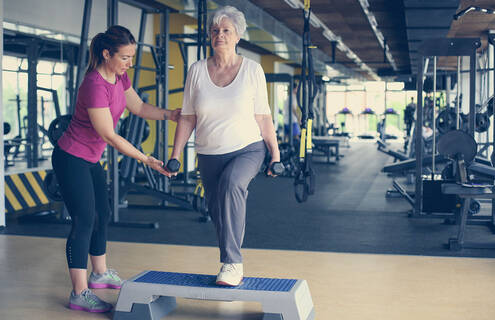
I want people to feel happy running, whether it's for two miles or 20 miles.
Most of us learned how to run as toddlers while chasing butterflies and playing tag.
But running as a sport later in life might not be as carefree. Running takes concentration, proper form and practice.
"Running is the only sport we assume we were born knowing how to do," says physical therapist Maria E. Oberlander, who leads the Running Gait Analysis clinic at Dartmouth Health's Cheshire Medical Center. "No one tells you how to run properly, and there's actually a lot of skill involved."
Improper form, muscle weakness or inadequate footwear can lead to running injuries. Common injuries include runner's knee, Achilles tendinopathy (an injury of the Achilles tendon) and shin splints.
How do you keep running injuries at bay if you're training for a marathon or just starting out?
Symptoms and causes of common running injuries
"Running doesn't have a greater injury risk than any other sport," Oberlander explains. "I see probably as many injuries in hockey players and swimmers as runners."
But running can cause injuries to the lower back, hips, knees, thighs, legs, ankles and feet. About 50% of runners experience an injury each year, potentially sidelining them for a bit, according to a 2021 research study.
Common running injuries include:
Runner's knee
- Symptoms: Pain around or behind the kneecap
- Causes: Weak hip and thigh muscles or poor running mechanics
Shin splints
- Symptoms: Pain along the inner shin
- Causes: Overuse, poor footwear or running on hard surfaces. More common in beginners or those increasing mileage too quickly
Achilles tendinopathy
- Symptoms: Pain, stiffness and swelling in the Achilles tendon
- Causes: Tight calves or improper footwear
Iliotibial (IT) band syndrome
- Symptoms: Pain on your outer knee, especially when running downhill
- Causes: Tightness in the IT band (PDF), weak hip muscles or poor running form
Plantar fasciitis
- Symptoms: Sharp heel or arch pain
- Causes: Inflammation of tissue along the bottom of the foot
Stress fractures
- Symptoms: Small cracks in bones, usually in your shin or foot
- Causes: Excessive training without enough recovery time. More common in runners with low bone density or lack of Vitamin D
Hamstring strains
- Symptoms: Pain or tightness in the back of your thigh
- Causes: Not warming up or taking strides that are too big
Ankle sprains
- Symptoms: Twisting or rolling of the ankle
- Causes: Running on uneven terrain or with weak ankle stability
Hip pain
- Symptoms: Burning sensation, ache, pain and stiffness
- Causes: Overuse, poor flexibility or muscle imbalances
Injuries or poor mechanics show up when you're tired
Research has shown that as runners grew tired, the biggest change in their form was in their trunk position. Turning your ankles inward while running can also happen when you're fatigued.
"You'll never find an injury or poor performance at the beginning of a run," Oberlander says. "It's always later when people start to tire."
A longtime runner, Oberlander started the Running Gait Analysis clinic in 2014. She works with runners who want to advance their skills or tackle performance challenges.
Oberlander typically first asks clients for a video of them running. She then watches it at slow speed to analyze their posture and alignment.
"You can't see the problem with the naked eye," she says, explaining that she slows the video to examine the impact of the runner's footwear, their stride and body alignment. "Evaluating their mechanics in slow motion is super important."
Avoiding injuries
"I always like to tell people to focus on their core strength first," says Jeffrey R. King, DPM, a podiatrist at Dartmouth Health's Mt. Ascutney Hospital and Health Center. "Make sure you properly warm up and stretch before running."
Here's how to prevent running injuries:
- Incorporate strength training into your weekly routine to target major muscle groups, such as your core, legs and hips.
- Work on your balance and stability with kickboxing, Pilates, yoga or strength training
- Slowly increase the demands put on your body to improve the flexibility of key muscle groups
- Include regular stretching into your routine
Proper running form makes a difference
Practicing proper running form can help you run faster, more comfortably and with less stress on your body. Experts suggest that you focus on the following:
Posture and head position
- Keep your head up and look 10 to 20 feet ahead
- Your posture should be upright
- Relax your shoulders
Core and torso
- Engage your core for stability
- Keep your torso upright
Arm movement
- Bend your elbows at a 90-degree angle
- Swing your arms naturally forward and back (not across)
- Keep your hands relaxed and don't clench your fists
Legs and feet
- Stride naturally and make sure your foot doesn't fall too far in front of you
- Land with your foot below your hips, not in front of your body
- Land midfoot and not on your heel
- Push off your toes for momentum
Remember to enjoy yourself
"Everybody should run because it's fun," Oberlander says. "I want people to feel happy running, whether it's for two miles or 20 miles."
Don't be discouraged by your running mistakes either, she says.
"I don't think many runners out there—even accomplished runners—will say they never made mistakes," Oberlander says. "We've all been there, so don't give up on yourself. Keep going and keep learning."


